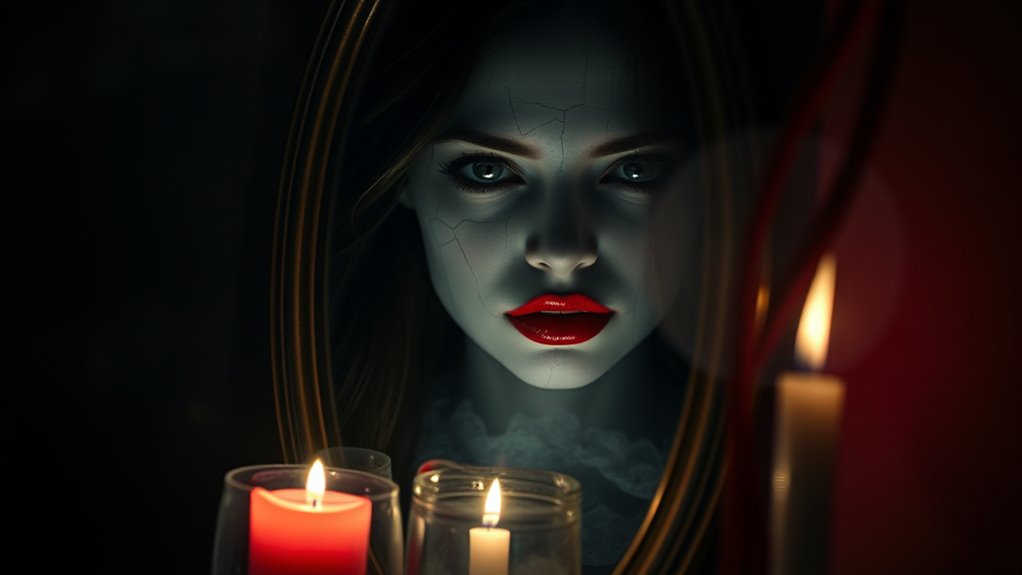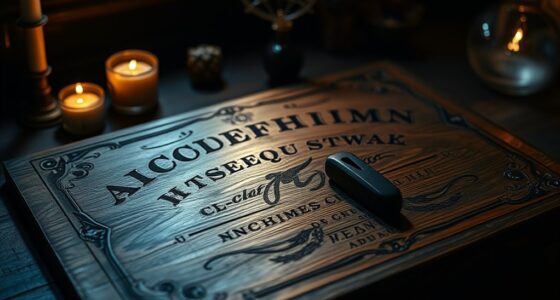Bloody Mary is a mix of fact and fiction. The name refers to Mary I of England, who earned her nickname for executing Protestants during her reign. However, the chilling ritual of summoning her by chanting in front of a mirror taps into folklore and cultural fears about female power. You might find the psychological effects of this eerie tradition even more fascinating, as well as other figures that haunt the legend. Curious to learn more?
Key Takeaways
- Bloody Mary refers to Mary I of England, whose brutal reign executed many Protestants, solidifying her historical infamy.
- The ritual of chanting “Bloody Mary” in front of a mirror is rooted in folklore and psychological effects, not historical fact.
- Psychological phenomena, like hallucinations, can occur during the ritual, blurring the line between reality and myth.
- Other figures, such as Elizabeth Báthory, contribute to the gruesome legend of Bloody Mary, enhancing its eerie narrative.
- The legend reflects societal fears surrounding female power and violence, intertwining with themes of superstition and cultural beliefs.

Whether you’re huddled around a flickering candle or gathered at a sleepover, the chilling legend of Bloody Mary has a way of engaging your imagination. This tale, often linked to Mary I of England, known as “Bloody Mary,” stems from her notorious reign from 1553 to 1558. During this time, she executed around 280 Protestants, a brutal act that cemented her infamous legacy.
The haunting legend of Bloody Mary captivates, intertwining history and myth in a chilling tale of power and fear.
But is there more to Bloody Mary than just a historical figure? The story intertwines with various elements of superstition and folklore, making it a fascinating subject for young women, especially during sleepovers.
When you perform the ritual, standing in front of a dimly lit mirror and chanting her name, you’re engaging in a tradition that mixes fear with curiosity. Many believe that the act can reveal your future husband or foretell death, reflecting deep-rooted cultural anxieties about women and power. The mirror becomes a portal, a psychological playing field where your mind can conjure images and faces, often influenced by the history of Mary I. As you stare into the glass, you might find yourself questioning the blurry line between reality and the supernatural.
Interestingly, the psychological effects of staring into a mirror for extended periods can lead to hallucinations—a phenomenon that could explain why so many claim to see apparitions. The fear and suspense that build in the atmosphere might heighten your senses, making the experience all the more intense. It’s not just about the legend; it’s also about how our minds work, especially in the dark.
While Mary I is the most recognized figure behind the legend, others like Elizabeth Báthory and Mary Worth have also become entwined in the folklore. Báthory, rumored to have tortured and killed hundreds of young women, adds a layer of gruesomeness to the tale, while Mary Worth is often depicted as a witch, enhancing the narrative’s eerie charm.
This blend of historical accounts and myth creates a rich tapestry of stories that make Bloody Mary a potent symbol of female power and violence, reflecting societal fears. Additionally, the legend of Bloody Mary can be seen as a reflection of ancient wisdom literature, illustrating how societal values shape our understanding of history and femininity.
Frequently Asked Questions
What Is the Origin of a Bloody Mary?
The origin of a Bloody Mary is steeped in history and legend. You’ll find that it’s often linked to Queen Mary I of England, notorious for her brutal persecution of Protestants.
Some connect it to Elizabeth Báthory, infamous for her gruesome acts. The ritual involves chanting her name in front of a mirror, tapping into deep-rooted fears surrounding women and power.
Each tale reflects societal anxieties, blending myth and reality throughout the ages.
Is Bloody Mary a Good or Bad Thing?
Whether Bloody Mary is a good or bad thing depends on your perspective.
If you see her as a symbol of fear and violence, you might view her negatively. However, if you consider the historical context and complexities of her life, you might find room for a more nuanced understanding.
Engaging with the legend can spark curiosity about history and folklore, allowing you to explore themes of mortality and superstition in a different light.
Why Was Bloody Mary Called Bloody Mary?
You might wonder why Mary I of England earned the nickname “Bloody Mary.”
It’s largely due to her brutal persecution of Protestants during her reign from 1553 to 1558. In her attempt to restore Catholicism, she oversaw the execution of around 280 individuals for heresy.
While her actions were undeniably harsh, understanding the intense religious conflict of her time can provide a more nuanced view of her complex legacy beyond just the violence.
What Is Bloody Mary’s Real Name?
You might be surprised to learn that the infamous “Bloody Mary” is actually Mary I of England. Born Mary Tudor, she was the daughter of Henry VIII and Catherine of Aragon.
Her reign, marked by the persecution of Protestants, earned her the chilling nickname due to her brutal methods.
While her name evokes fear, it also intertwines with legends and folklore, creating a complex legacy that goes beyond just one historical figure.
Conclusion
In the end, whether you believe in Bloody Mary or dismiss her as mere folklore, the legend remains a fascinating part of cultural history. Curiously, a survey revealed that about 25% of people claim to have participated in the ritual, showcasing its enduring allure. This blend of fear and fascination keeps the myth alive, inviting you to ponder the mysteries that lie beyond the mirror. So, next time you’re feeling brave, will you dare to summon her?









